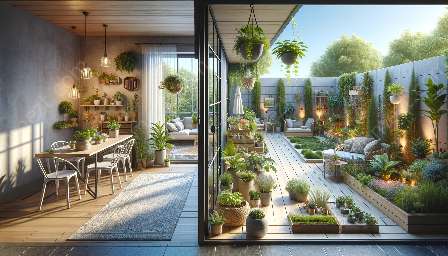Introduction to Soil Preparation and Fertilization
Soil preparation and fertilization are essential components of successful gardening, both indoors and outdoors. In this comprehensive guide, we will explore the best practices for soil preparation and fertilization to ensure healthy and thriving plants. Additionally, we will touch on how these practices can enhance the overall beauty of your home, making them an integral part of homemaking and interior decor.
Understanding Soil Preparation
Soil composition and structure play a crucial role in plant growth and development. Whether you are tending to indoor houseplants or maintaining an outdoor garden, proper soil preparation is essential for providing the necessary nutrients and support for your plants. Here are some key steps to consider:
- Testing the Soil: Before planting, it is important to test the soil to determine its pH level and nutrient content. This will help you understand the specific needs of your plants and how to best prepare the soil.
- Amending the Soil: Based on the results of soil testing, you may need to amend the soil to optimize its composition. This can involve adding organic matter, such as compost or well-rotted manure, to improve soil structure and nutrient availability.
- Aeration and Drainage: Good soil aeration and drainage are essential for healthy root development. For indoor plants, choose potting mixtures that provide adequate aeration and drainage. Outdoor gardens may require tilling or loosening the soil to enhance aeration.
The Role of Fertilization
Fertilization is the process of replenishing essential nutrients in the soil that may be lacking or depleted over time. By understanding the nutrient requirements of your plants, you can effectively utilize fertilization to promote robust growth and vibrant blooms:
- Types of Fertilizers: There are various types of fertilizers available, including organic and synthetic options. Organic fertilizers, such as compost or fish emulsion, provide a slow release of nutrients and improve soil health over time. Synthetic fertilizers typically offer more immediate and targeted nutrient delivery.
- Application Techniques: Whether you are fertilizing indoor plants or an outdoor garden, it's important to follow proper application techniques. This includes evenly distributing the fertilizer and avoiding direct contact with plant foliage, which can cause damage.
- Seasonal Considerations: Fertilization needs may vary with the changing seasons. In the spring, plants may benefit from a balanced, all-purpose fertilizer to support new growth. During the growing season, consider using a fertilizer with higher levels of nitrogen to encourage lush foliage and strong stems. In the fall, a fertilizer with higher phosphorus content can help promote root development and winter hardiness.
Indoor Gardening: Adding Greenery to Your Living Spaces
Indoor gardening offers a wonderful opportunity to bring the beauty of nature into your home. When it comes to soil preparation and fertilization for indoor plants, consider the following tips:
- Choosing the Right Containers: Selecting the appropriate containers for indoor plants is essential for proper soil preparation and nutrient retention. Ensure that the containers have drainage holes to prevent waterlogged soil.
- Optimizing Indoor Potting Mix: Use a high-quality potting mix specifically designed for indoor plants. These mixes are lightweight, well-draining, and formulated with the necessary nutrients for healthy growth.
- Understanding Light and Water Needs: Indoor plants have specific light and water requirements. Tailor your soil preparation and fertilization efforts to accommodate the unique needs of each plant species in your indoor garden.
Outdoor Gardening: Creating Stunning Outdoor Living Spaces
Transforming your outdoor spaces into lush, thriving gardens involves careful consideration of soil preparation and fertilization methods:
- Sustainable Gardening Practices: Embrace sustainable gardening practices by incorporating composting and organic fertilizers into your outdoor soil preparation and fertilization routines. This promotes environmental stewardship and supports long-term soil health.
- Soil Testing and Analysis: Regular soil testing is key to understanding the evolving nutrient needs of your outdoor garden. Make proactive adjustments to the soil composition based on test results and seasonal changes.
- Fertilization Timing: Coordinate your fertilization schedule with the natural growth cycles of your outdoor plants. By timing fertilization appropriately, you can maximize its effectiveness and minimize environmental impact.
Fusion of Homemaking and Interior Decor
Soil preparation and fertilization extend beyond the realm of gardening, enriching the overall aesthetic appeal of your living spaces. Consider the following ways to integrate these practices into your homemaking and interior decor:
- Decorative Plant Containers: Choose stylish and complementary plant containers that harmonize with your interior decor. These containers can serve as decorative accents while providing a functional base for proper soil preparation.
- Indoor Greenery as Design Elements: Strategically placing indoor plants can add visual interest and harmony to your home's interior decor. Consider the colors, textures, and shapes of the plants to enhance the overall ambiance.
- Showcasing Outdoor Garden Beauty: Extend the beauty of your outdoor garden into your living spaces by creating arrangements or display areas that highlight the lushness and vibrancy of your plants. This seamless integration enhances the overall aesthetic appeal of your home.
Conclusion
Soil preparation and fertilization serve as the foundational elements for successful indoor and outdoor gardening. By incorporating these practices into your homemaking and interior decor endeavors, you can cultivate beauty that resonates throughout your living spaces. From fostering healthy plant growth to enhancing the visual allure of your home, the art of soil preparation and fertilization has a profound impact on both your surroundings and your well-being.


